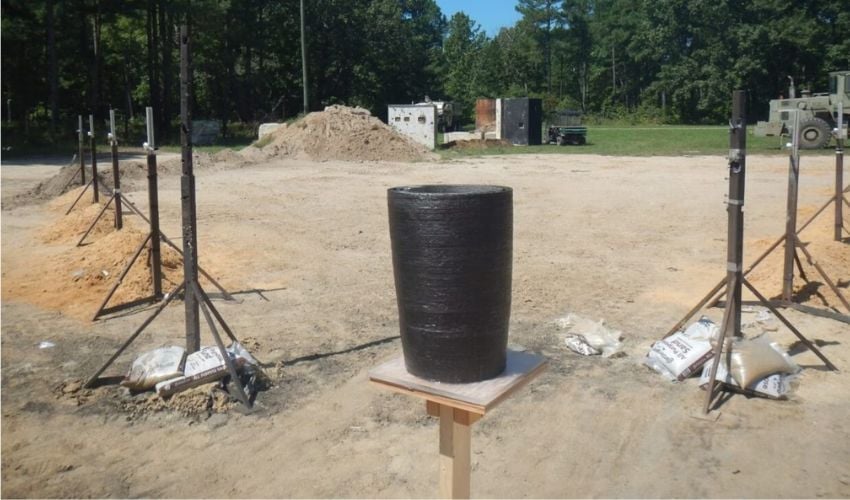Groundbreaking First Arena Test on 3D Printed Bombs Shows Promise

For much of his career, Russ Maines has been dedicated to designing bombs with cast, forged or pressed metals. However, these bombs were expensive and not scalable. So, as a Test and Evaluation Division Director at the Naval Surface Warfare Center Indian Head Division (NSWC IHD), he aims to combine traditional manufacturing technology with innovative methods like 3D printing. Now, the NSWC IHD has completed the first arena tests on general bombs with 3D printed cross-sections, and the results were more than promising.
The tests, completed at Fort Walker, Virginia, used a bomb that was 3D printed by Oak Ridge National Laboratory (ORNL) for the Defense Threat Reduction Agency. It was provided to NSWC IHD so they could assess its lethality. According to the NSWC IHD press release, Detonation and Combustion Technology Branch engineers oversaw the test and hand-packed the novel case with C4. Then, they staged the arena, set up cameras and monitored gauges for data collection.

Test arena immediately after detonation of the test article
While more tests are needed, these first tests were successful. Maines explained, “So far, the data says there’s no reason to stop. And now, we see our models need adjustments.” The team’s data showed that the bombs were not only effective but also had qualities that were not even expected. For instance, they reported improved blast physics and bomb fragmentation.
While bomb performance is key to their mission, the NSWC IHD is also exploring 3D printing bombs because it could mean faster and cheaper production. The bombs used in the Fort Walker tests already cost three times less than traditional methods at a low rate of production. The advancement comes at a time when the US Navy is facing a higher demand for munitions than it has for decades, along with a fragile supply chain.
“Digitally transforming weapons manufacturing will create new Department of Defense [DoD] pipelines that only strengthen supply chains,” Maines said. “And while we’re at it, we could leverage this technology to make bombs quicker, cheaper, and most importantly, better. And as the Navy’s only publicly funded arsenal, Indian Head is uniquely positioned to do it.”
3D printing of highly sophisticated weapons is still in early development, but the technology clearly demonstrates advantages. Used alongside other innovative manufacturing methods, the US Navy and the DoD will continue to push for improved technology that is faster to produce and less expensive. Chief of Naval Operations Adm. Lisa Franchetti claimed “advancements in battlefield innovation with profound implications for the changing character of war.” To learn more about the project, read the NSWC IHD story here.
What do you think of the NSWC IHD’s work on 3D printed bombs? Do you think 3D printed bombs are in the future of warfare? Let us know in a comment below or on our Linkedin, Facebook, and Twitter pages! Don’t forget to sign up for our free weekly Newsletter here, the latest 3D printing news straight to your inbox! You can also find all our videos on our YouTube channel.
*All Photo Credits: NSWC IHD. Cover photo: Section of 3D printed bomb case under test.






